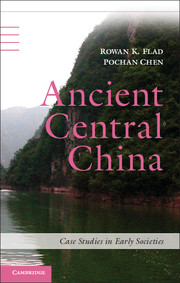Book contents
- Frontmatter
- Contents
- Figures
- Tables
- Boxes
- Acknowledgments
- 1 Introduction: Centers and Peripheries in the Ancient Yangzi River Valley
- Part I Setting the Stage
- Part II Political and Cultural Topographies
- 4 The Sichuan Basin: Shu and Its Predecessors
- 5 The Middle Yangzi: The Archaeology and History of Chu and Its Predecessors
- 6 Periphery at the Center: The Ba and Archaeological Cultures in the Three Gorges
- Part III Topographies of Economic Activity and Ritual
- Glossary
- Bibliography
- Index
4 - The Sichuan Basin: Shu and Its Predecessors
Published online by Cambridge University Press: 05 February 2013
- Frontmatter
- Contents
- Figures
- Tables
- Boxes
- Acknowledgments
- 1 Introduction: Centers and Peripheries in the Ancient Yangzi River Valley
- Part I Setting the Stage
- Part II Political and Cultural Topographies
- 4 The Sichuan Basin: Shu and Its Predecessors
- 5 The Middle Yangzi: The Archaeology and History of Chu and Its Predecessors
- 6 Periphery at the Center: The Ba and Archaeological Cultures in the Three Gorges
- Part III Topographies of Economic Activity and Ritual
- Glossary
- Bibliography
- Index
Summary
Historical Accounts of Shu
As suggested in Chapter 3, the Sichuan Basin has been considered a region of secondary historical importance, even by those whose research has been focused there. For example, in his 1957 synthesis of the archaeology of Sichuan, Cheng Te-k'un (1957: xix) stated, “Szechwan is fundamentally a marginal area, and the culture of this province has never been a result of independent development. It has always been under the influence of some neighboring culture.”
In our opinion, cultural development always occurs with some influence from neighboring cultures. If one puts this issue to the side, however, recent work in Sichuan has made the archaeological community more willing to accept that indigenous communities within Sichuan played a significant role in local social developments and, consequently, that Sichuan was not “fundamentally a marginal area.”
Here our attention focuses on the pre-Qin period in the Chengdu Plain, where archaeological evidence related to political and cultural topographies is more robust than elsewhere in the Sichuan Basin and where historical records place the core of the Shu kingdom. During various periods, states with the name “Shu” were located in the Sichuan region. The Former Shu (A.D. 907–925) and Later Shu (A.D. 934–965) were two of the Ten Kingdoms during the era of Five Dynasties and Ten Kingdoms (A.D. 907–960). This state took its name from the Shu-Han kingdom (A.D. 221–263) of the Three Kingdoms period (A.D. 220–280). The name of this state, in turn, referenced the Shu kingdom of the Sichuan Basin that was conquered by Qin in 316 B.C. (see Sage 1992).
- Type
- Chapter
- Information
- Ancient Central ChinaCenters and Peripheries along the Yangzi River, pp. 71 - 107Publisher: Cambridge University PressPrint publication year: 2013



